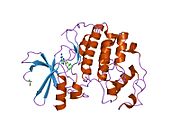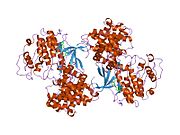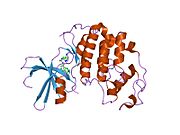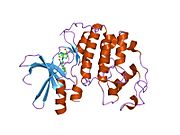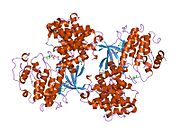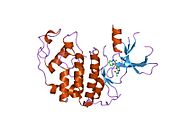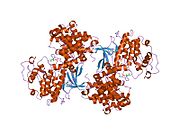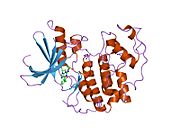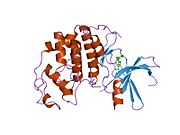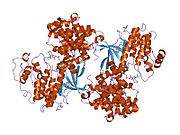Biology:Cyclin-dependent kinase 2
 Generic protein structure example |
Cyclin-dependent kinase 2, also known as cell division protein kinase 2, or Cdk2, is an enzyme that in humans is encoded by the CDK2 gene.[1][2] The protein encoded by this gene is a member of the cyclin-dependent kinase family of Ser/Thr protein kinases. This protein kinase is highly similar to the gene products of S. cerevisiae cdc28, and S. pombe cdc2, also known as Cdk1 in humans. It is a catalytic subunit of the cyclin-dependent kinase complex, whose activity is restricted to the G1-S phase of the cell cycle, where cells make proteins necessary for mitosis and replicate their DNA. This protein associates with and is regulated by the regulatory subunits of the complex including cyclin E or A. Cyclin E binds G1 phase Cdk2, which is required for the transition from G1 to S phase while binding with Cyclin A is required to progress through the S phase.[3] Its activity is also regulated by phosphorylation. Multiple alternatively spliced variants and multiple transcription initiation sites of this gene have been reported.[4] The role of this protein in G1-S transition has been recently questioned as cells lacking Cdk2 are reported to have no problem during this transition.[5]
Dispensability in normally functioning tissue
Original cell-culture based experiments demonstrated cell cycle arrest at the G1-S transition resulting from the deletion of Cdk2.[6] Later experiments showed that Cdk2 deletions lengthened the G1 phase of the cell cycle in mouse embryo fibroblasts. However, they still entered S phase after this period and were able to complete the remaining phases of the cell cycle.[7] When Cdk2 was deleted in mice, the animals remained viable despite a reduction in body size. However, meiotic function of both male and female mice was inhibited. This suggests that Cdk2 is non-essential for the cell cycle of healthy cells, but essential for meiosis and reproduction.[6] Cells in Cdk2 knockout mice likely undergo fewer divisions, contributing to the reduction in body size. Germ cells also stop dividing at prophase of meiosis, leading to reproductive sterility.[7] Cdk1 is now believed to compensate for many aspects of Cdk2 deletion, except for meiotic function.[6]
Mechanism of activation
Cyclin-dependent kinase 2 is structured in two lobes. The lobe beginning at the N-terminus (N-lobe) contains many beta sheets, while the C-terminus lobe (C-lobe) is rich in alpha helices.[3] Cdk2 is capable of binding to many different cyclins, including cyclins A, B, E, and possibly C.[6] Recent studies suggest Cdk2 binds preferentially to cyclins A and E, while Cdk1 prefers cyclins A and B.[8]

Cdk2 becomes active when a cyclin protein (either A or E) binds at the active site located between the N and C lobes of the kinase. Due to the location of the active site, partner cyclins interact with both lobes of Cdk2. Cdk2 contains an important alpha helix located in the C lobe of the kinase, called the C-helix or the PSTAIRE-helix. Hydrophobic interactions cause the C-helix to associate with another helix in the activating cyclin. Activation induces a conformational change where the helix rotates and moves closer to the N-lobe.[citation needed] This allows the glutamic acid located on the C-helix to form an ion pair with a nearby lysine side chain. The significance of this movement is that it brings the side chain of Glu 51, which belongs to a triad of catalytic site residues conserved in all eukaryotic kinases, into the catalytic site. This triad (Lys 33, Glu 51 and Asp 145) is involved in ATP phosphate orientation and magnesium coordination, and is thought to be critical for catalysis. This conformational change also relocates the activation loop to the C-lobe, revealing the ATP binding site now available for new interactions. Finally, the Threonine-160 residue is exposed and phosphorylated as the C-lobe activation segment is displaced from the catalytic site and the threonine residue is no longer sterically hindered. The phosphorylated threonine residue creates stability in the final enzyme conformation. It is important to note that throughout this activation process, cyclins binding to Cdk2 do not undergo any conformational change.[10][3]

Role in DNA replication
The success of the cell division process is dependent on the precise regulation of processes at both cellular and tissue levels. Complex interactions between proteins and DNA within the cell allow genomic DNA to be passed to daughter cells. Interactions between cells and extracellular matrix proteins allow new cells to be incorporated into existing tissues. At the cellular level, the process is controlled by different levels of cyclin-dependent kinases (Cdks) and their partner cyclins. Cells utilize various checkpoints as a means of delaying cell cycle progression until it can repair defects.[12]
Cdk2 is active during G1 and S phase of the cell cycle, and therefore acts as a G1-S phase checkpoint control. Prior to G1 phase, levels of Cdk4 and Cdk6 increase along with cyclin D. This allows for the partial phosphorylation of Rb, and partial activation of E2F at the beginning of G1 phase, which promotes cyclin E synthesis and increased Cdk2 activity. At the end of G1 phase, the Cdk2/Cyclin E complex reaches maximum activity and plays a significant role in the initiation of S phase.[13] Other non-Cdk proteins also become active during the G1-S phase transition. For example, the retinoblastoma (Rb) and p27 proteins are phosphorylated by Cdk2 – cyclin A/E complexes, fully deactivating them.[14] This allows E2F transcription factors to express genes that promote entry into S phase where DNA is replicated prior to division.[15][16][14] Additionally, NPAT, a known substrate of the Cdk2-Cyclin E complex, functions to activate histone gene transcription when phosphorylated.[17] This increases the synthesis of histone proteins (the major protein component of chromatin), and subsequently supports the DNA replication stage of the cell cycle. Finally, at the end of S phase, the ubiquitin proteasome degrades cyclin E.[7]
Cancer cell proliferation
Although Cdk2 is mostly dispensable in the cell cycle of normally functioning cells, it is critical to the abnormal growth processes of cancer cells. The CCNE1 gene produces cyclin E, one of the two major protein binding partners of Cdk2. Overexpression of CCNE1 occurs in many tumor cells, causing the cells to become dependent on Cdk2 and cyclin E.[8] Abnormal cyclin E activity is also observed in breast, lung, colorectal, gastric, and bone cancers, as well as in leukemia and lymphoma.[13] Likewise, abnormal expression of cyclin A2 is associated with chromosomal instability and tumor proliferation, while inhibition leads to decreased tumor growth.[18] Therefore, CDK2 and its cyclin binding partners represent possible therapeutic targets for new cancer therapeutics.[8] Pre-clinical models have shown preliminary success in limiting tumor growth, and have also been observed to reduce side effects of current chemotherapy drugs.[19][20][21]
Identifying selective Cdk2 inhibitors is difficult due to the extreme similarity between the active sites of Cdk2 and other Cdks, especially Cdk1.[8] Cdk1 is the only essential cyclin dependent kinase in the cell cycle, and inhibition could lead to unintended side effects.[22] Most CDK2 inhibitor candidates target the ATP binding site and can be divided into two main subclasses: type I and type II. Type I inhibitors competitively target the ATP binding site in its active state. Type II inhibitors target CDK2 in its unbound state, either occupying the ATP binding site or hydrophobic pocket within the kinase. Type II inhibitors are believed to be more selective.[20] Recently, the availability of new CDK crystal structures led to the identification of a potential allosteric binding site near the C-helix. Inhibitors of this allosteric site are classified as type III inhibitors.[23] Another possible target is the T-loop of CDK2. When cyclin A binds to CDK2, the N-terminal lobe rotates to activate the ATP binding site and switch the position of the activation loop, called the T-loop.[24]
Inhibitors
Interpretation of dynamic simulations and binding free energy studies unveiled that Ligand2 (Out of 17 in-house synthesized pyrrolone-fused benzosuberene (PBS) compounds) has a stable and equivalent free energy to Flavopiridol, SU9516, and CVT-313 inhibitors. Ligand2 scrutinized as a selective inhibitor of CDK2 without off-target binding (CDK1 and CDK9) based on ligand efficiency and binding affinity. [25]

Known CDK inhibitors are p21Cip1 (CDKN1A) and p27Kip1 (CDKN1B).[26]
Drugs that inhibit Cdk2 and arrest the cell cycle, such as GW8510 and the experimental cancer drug seliciclib, may reduce the sensitivity of the epithelium to many cell cycle-active antitumor agents and, therefore, represent a strategy for prevention of chemotherapy-induced alopecia.[27]
Rosmarinic acid methyl ester is a plant-derived Cdk2 inhibitor, which was shown to suppress proliferation of vascular smooth muscle cells and to reduce neointima formation in mouse restenosis model.[28]
See also the PDB gallery below showing interactions with many inhibitors (inc Purvalanol B)
Gene regulation
In melanocytic cell types, expression of the CDK2 gene is regulated by the Microphthalmia-associated transcription factor.[29][30]
Interactions
Cyclin-dependent kinase 2 has been shown to interact with:
- BRCA1,[31][32][33]
- CDK2AP1,[34]
- CDKN1B[35][36][37][38][39]
- CDKN3,[40][41][42]
- CEBPA,[43]
- Cyclin A1,[44][45][46][47]
- Cyclin E1,[35][48][49][50][51][52]
- Flap structure-specific endonuclease 1,[53]
- ORC1L,[54]
- P21,[39][42][49][55][56]
- PPM1B,[57]
- PPP2CA,[57]
- Retinoblastoma-like protein 1,[48][58]
- Retinoblastoma-like protein 2,[48][59] and
- SKP2.[36][55][60]

References
- ↑ "Isolation of the human cdk2 gene that encodes the cyclin A- and adenovirus E1A-associated p33 kinase". Nature 353 (6340): 174–7. September 1991. doi:10.1038/353174a0. PMID 1653904. Bibcode: 1991Natur.353..174T.
- ↑ "Entrez Gene: CDK2 cyclin-dependent kinase 2". https://www.ncbi.nlm.nih.gov/sites/entrez?Db=gene&Cmd=ShowDetailView&TermToSearch=1017.
- ↑ 3.0 3.1 3.2 "Recent developments in cyclin-dependent kinase biochemical and structural studies". Biochimica et Biophysica Acta (BBA) - Proteins and Proteomics 1804 (3): 511–9. March 2010. doi:10.1016/j.bbapap.2009.10.002. PMID 19822225.
- ↑ "Entrez Gene: CDK2 cyclin-dependent kinase 2". https://www.ncbi.nlm.nih.gov/sites/entrez?Db=gene&Cmd=ShowDetailView&TermToSearch=1017.
- ↑ "Cdk2 knockout mice are viable". Current Biology 13 (20): 1775–85. October 2003. doi:10.1016/j.cub.2003.09.024. PMID 14561402.
- ↑ 6.0 6.1 6.2 6.3 "Mammalian cell-cycle regulation: several Cdks, numerous cyclins and diverse compensatory mechanisms". Oncogene 28 (33): 2925–39. August 2009. doi:10.1038/onc.2009.170. PMID 19561645.
- ↑ 7.0 7.1 7.2 "Promiscuity rules? The dispensability of cyclin E and Cdk2". Science's STKE 2004 (224): pe11. March 2004. doi:10.1126/stke.2242004pe11. PMID 15026579.
- ↑ 8.0 8.1 8.2 8.3 "Differences in the Conformational Energy Landscape of CDK1 and CDK2 Suggest a Mechanism for Achieving Selective CDK Inhibition". Cell Chemical Biology 26 (1): 121–130.e5. November 2018. doi:10.1016/j.chembiol.2018.10.015. PMID 30472117.
- ↑ PDB: 1FIN; "Mechanism of CDK activation revealed by the structure of a cyclinA-CDK2 complex". Nature 376 (6538): 313–20. July 1995. doi:10.1038/376313a0. PMID 7630397. Bibcode: 1995Natur.376..313J.
- ↑ "Cyclin-dependent kinases". Genome Biology 15 (6): 122. 2014-06-30. doi:10.1186/gb4184. PMID 25180339.
- ↑ PDB: 1W98; "The structure of cyclin E1/CDK2: implications for CDK2 activation and CDK2-independent roles". The EMBO Journal 24 (3): 452–63. February 2005. doi:10.1038/sj.emboj.7600554. PMID 15660127.
- ↑ "Checking on DNA damage in S phase". Nature Reviews. Molecular Cell Biology 5 (10): 792–804. October 2004. doi:10.1038/nrm1493. PMID 15459660.
- ↑ 13.0 13.1 "Low-Molecular-Weight Cyclin E in Human Cancer: Cellular Consequences and Opportunities for Targeted Therapies". Cancer Research 78 (19): 5481–5491. October 2018. doi:10.1158/0008-5472.can-18-1235. PMID 30194068.
- ↑ 14.0 14.1 "RB and cell cycle progression". Oncogene 25 (38): 5220–7. August 2006. doi:10.1038/sj.onc.1209615. PMID 16936740.
- ↑ "Pocket proteins and cell cycle control". Oncogene 24 (17): 2796–809. April 2005. doi:10.1038/sj.onc.1208619. PMID 15838516.
- ↑ The molecular basis of cancer. Mendelsohn, John, 1936-, Gray, Joe W.,, Howley, Peter M.,, Israel, Mark A.,, Thompson, Craig (Craig B.) (Fourth ed.). Philadelphia, PA. 2015. ISBN 9781455740666. OCLC 870870610.
- ↑ "NPAT links cyclin E-Cdk2 to the regulation of replication-dependent histone gene transcription". Genes & Development 14 (18): 2283–97. September 2000. doi:10.1101/gad.827700. PMID 10995386.
- ↑ "Loss of Cdk2 and cyclin A2 impairs cell proliferation and tumorigenesis". Cancer Research 74 (14): 3870–9. July 2014. doi:10.1158/0008-5472.CAN-13-3440. PMID 24802190.
- ↑ "Inhibition of cyclin-dependent kinase 2 protects against doxorubicin-induced cardiomyocyte apoptosis and cardiomyopathy". The Journal of Biological Chemistry 293 (51): 19672–19685. October 2018. doi:10.1074/jbc.ra118.004673. PMID 30361442.
- ↑ 20.0 20.1 "Inhibitors of cyclin-dependent kinases as cancer therapeutics". Pharmacology & Therapeutics 173: 83–105. May 2017. doi:10.1016/j.pharmthera.2017.02.008. PMID 28174091.
- ↑ "Roscovitine in cancer and other diseases". Annals of Translational Medicine 3 (10): 135. June 2015. doi:10.3978/j.issn.2305-5839.2015.03.61. PMID 26207228.
- ↑ "CDK1 structures reveal conserved and unique features of the essential cell cycle CDK". Nature Communications 6: 6769. April 2015. doi:10.1038/ncomms7769. PMID 25864384. Bibcode: 2015NatCo...6.6769B.
- ↑ "Structure-based discovery of the first allosteric inhibitors of cyclin-dependent kinase 2". Cell Cycle 13 (14): 2296–305. 2014-06-09. doi:10.4161/cc.29295. PMID 24911186.
- ↑ "Targeting Conformational Activation of CDK2 Kinase". Biotechnology Journal 12 (8): 1600531. August 2017. doi:10.1002/biot.201600531. PMID 28430399.
- ↑ 25.0 25.1 "Identification of selective cyclin-dependent kinase 2 inhibitor from the library of pyrrolone-fused benzosuberene compounds: an in silico exploration". Journal of Biomolecular Structure and Dynamics 40 (17): 7693–7701. March 2021. doi:10.1080/07391102.2021.1900918. PMID 33749525. https://figshare.com/articles/journal_contribution/14259911.
- ↑ "Cleavage of p21Cip1/Waf1 and p27Kip1 mediates apoptosis in endothelial cells through activation of Cdk2: role of a caspase cascade". Molecular Cell 1 (4): 553–63. March 1998. doi:10.1016/S1097-2765(00)80055-6. PMID 9660939.
- ↑ "Prevention of chemotherapy-induced alopecia in rats by CDK inhibitors". Science 291 (5501): 134–7. January 2001. doi:10.1126/science.291.5501.134. PMID 11141566. Bibcode: 2001Sci...291..134D.
- ↑ "Constituents of Mediterranean Spices Counteracting Vascular Smooth Muscle Cell Proliferation: Identification and Characterization of Rosmarinic Acid Methyl Ester as a Novel Inhibitor". Molecular Nutrition & Food Research 62 (7): e1700860. April 2018. doi:10.1002/mnfr.201700860. PMID 29405576.
- ↑ "Critical role of CDK2 for melanoma growth linked to its melanocyte-specific transcriptional regulation by MITF". Cancer Cell 6 (6): 565–76. December 2004. doi:10.1016/j.ccr.2004.10.014. PMID 15607961.
- ↑ "Novel MITF targets identified using a two-step DNA microarray strategy". Pigment Cell & Melanoma Research 21 (6): 665–76. December 2008. doi:10.1111/j.1755-148X.2008.00505.x. PMID 19067971.
- ↑ "BRCA1 is a 220-kDa nuclear phosphoprotein that is expressed and phosphorylated in a cell cycle-dependent manner". Cancer Research 56 (14): 3168–72. July 1996. PMID 8764100.
- ↑ "BRCA1 is phosphorylated at serine 1497 in vivo at a cyclin-dependent kinase 2 phosphorylation site". Molecular and Cellular Biology 19 (7): 4843–54. July 1999. doi:10.1128/MCB.19.7.4843. PMID 10373534.
- ↑ "BRCA1 proteins are transported to the nucleus in the absence of serum and splice variants BRCA1a, BRCA1b are tyrosine phosphoproteins that associate with E2F, cyclins and cyclin dependent kinases". Oncogene 15 (2): 143–57. July 1997. doi:10.1038/sj.onc.1201252. PMID 9244350.
- ↑ "p12(DOC-1) is a novel cyclin-dependent kinase 2-associated protein". Molecular and Cellular Biology 20 (17): 6300–7. September 2000. doi:10.1128/MCB.20.17.6300-6307.2000. PMID 10938106.
- ↑ 35.0 35.1 "CRM1/Ran-mediated nuclear export of p27(Kip1) involves a nuclear export signal and links p27 export and proteolysis". Molecular Biology of the Cell 14 (1): 201–13. January 2003. doi:10.1091/mbc.E02-06-0319. PMID 12529437.
- ↑ 36.0 36.1 "Tuberin binds p27 and negatively regulates its interaction with the SCF component Skp2". The Journal of Biological Chemistry 279 (47): 48707–15. November 2004. doi:10.1074/jbc.M405528200. PMID 15355997.
- ↑ "Bcl-2 expression suppresses mismatch repair activity through inhibition of E2F transcriptional activity". Nature Cell Biology 7 (2): 137–47. February 2005. doi:10.1038/ncb1215. PMID 15619620.
- ↑ "Spy1 interacts with p27Kip1 to allow G1/S progression". Molecular Biology of the Cell 14 (9): 3664–74. September 2003. doi:10.1091/mbc.E02-12-0820. PMID 12972555.
- ↑ 39.0 39.1 "Rapamycin potentiates transforming growth factor beta-induced growth arrest in nontransformed, oncogene-transformed, and human cancer cells". Molecular and Cellular Biology 22 (23): 8184–98. December 2002. doi:10.1128/mcb.22.23.8184-8198.2002. PMID 12417722.
- ↑ "Abolishment of the interaction between cyclin-dependent kinase 2 and Cdk-associated protein phosphatase by a truncated KAP mutant". Biochemical and Biophysical Research Communications 305 (2): 311–4. May 2003. doi:10.1016/s0006-291x(03)00757-5. PMID 12745075.
- ↑ "KAP: a dual specificity phosphatase that interacts with cyclin-dependent kinases". Proceedings of the National Academy of Sciences of the United States of America 91 (5): 1731–5. March 1994. doi:10.1073/pnas.91.5.1731. PMID 8127873. Bibcode: 1994PNAS...91.1731H.
- ↑ 42.0 42.1 "The p21 Cdk-interacting protein Cip1 is a potent inhibitor of G1 cyclin-dependent kinases". Cell 75 (4): 805–16. November 1993. doi:10.1016/0092-8674(93)90499-g. PMID 8242751.
- ↑ "C/EBPalpha arrests cell proliferation through direct inhibition of Cdk2 and Cdk4". Molecular Cell 8 (4): 817–28. October 2001. doi:10.1016/s1097-2765(01)00366-5. PMID 11684017.
- ↑ "A distinct cyclin A is expressed in germ cells in the mouse". Development 122 (1): 53–64. January 1996. doi:10.1242/dev.122.1.53. PMID 8565853.
- ↑ "Characterization of a second human cyclin A that is highly expressed in testis and in several leukemic cell lines". Cancer Research 57 (5): 913–20. March 1997. PMID 9041194.
- ↑ "Cyclin A1 directly interacts with B-myb and cyclin A1/cdk2 phosphorylate B-myb at functionally important serine and threonine residues: tissue-specific regulation of B-myb function". Blood 97 (7): 2091–7. April 2001. doi:10.1182/blood.v97.7.2091. PMID 11264176.
- ↑ "The structural basis for specificity of substrate and recruitment peptides for cyclin-dependent kinases". Nature Cell Biology 1 (7): 438–43. November 1999. doi:10.1038/15674. PMID 10559988.
- ↑ 48.0 48.1 48.2 "Cyclin E associates with BAF155 and BRG1, components of the mammalian SWI-SNF complex, and alters the ability of BRG1 to induce growth arrest". Molecular and Cellular Biology 19 (2): 1460–9. February 1999. doi:10.1128/mcb.19.2.1460. PMID 9891079.
- ↑ 49.0 49.1 "P21Waf1/Cip1 dysfunction in neuroblastoma: a novel mechanism of attenuating G0-G1 cell cycle arrest". Cancer Research 63 (13): 3840–4. July 2003. PMID 12839982.
- ↑ "Formation and activation of a cyclin E-cdk2 complex during the G1 phase of the human cell cycle". Science 257 (5077): 1689–94. September 1992. doi:10.1126/science.1388288. PMID 1388288. Bibcode: 1992Sci...257.1689K.
- ↑ "mTOR-dependent activation of the transcription factor TIF-IA links rRNA synthesis to nutrient availability". Genes & Development 18 (4): 423–34. February 2004. doi:10.1101/gad.285504. PMID 15004009.
- ↑ "NIPP1-mediated interaction of protein phosphatase-1 with CDC5L, a regulator of pre-mRNA splicing and mitotic entry". The Journal of Biological Chemistry 275 (33): 25411–7. August 2000. doi:10.1074/jbc.M001676200. PMID 10827081.
- ↑ "Phosphorylation of human Fen1 by cyclin-dependent kinase modulates its role in replication fork regulation". Oncogene 22 (28): 4301–13. July 2003. doi:10.1038/sj.onc.1206606. PMID 12853968.
- ↑ "Human origin recognition complex large subunit is degraded by ubiquitin-mediated proteolysis after initiation of DNA replication". Molecular Cell 9 (3): 481–91. March 2002. doi:10.1016/s1097-2765(02)00467-7. PMID 11931757.
- ↑ 55.0 55.1 "Regulation of cyclin A-Cdk2 by SCF component Skp1 and F-box protein Skp2". Molecular and Cellular Biology 19 (1): 635–45. January 1999. doi:10.1128/mcb.19.1.635. PMID 9858587.
- ↑ "TOK-1, a novel p21Cip1-binding protein that cooperatively enhances p21-dependent inhibitory activity toward CDK2 kinase". The Journal of Biological Chemistry 275 (40): 31145–54. October 2000. doi:10.1074/jbc.M003031200. PMID 10878006.
- ↑ 57.0 57.1 "Dephosphorylation of human cyclin-dependent kinases by protein phosphatase type 2C alpha and beta 2 isoforms". The Journal of Biological Chemistry 275 (44): 34744–9. November 2000. doi:10.1074/jbc.M006210200. PMID 10934208.
- ↑ "Reversal of growth suppression by p107 via direct phosphorylation by cyclin D1/cyclin-dependent kinase 4". Molecular and Cellular Biology 22 (7): 2242–54. April 2002. doi:10.1128/mcb.22.7.2242-2254.2002. PMID 11884610.
- ↑ "Identification of a p130 domain mediating interactions with cyclin A/cdk 2 and cyclin E/cdk 2 complexes". Oncogene 14 (20): 2395–406. May 1997. doi:10.1038/sj.onc.1201085. PMID 9188854.
- ↑ "Interaction between ubiquitin-protein ligase SCFSKP2 and E2F-1 underlies the regulation of E2F-1 degradation". Nature Cell Biology 1 (1): 14–9. May 1999. doi:10.1038/8984. PMID 10559858.
Further reading
- "Cell cycle sibling rivalry: Cdc2 vs. Cdk2". Cell Cycle 4 (11): 1491–4. November 2005. doi:10.4161/cc.4.11.2124. PMID 16258277.
- "Cyclin dependent kinase 2 and the regulation of human progesterone receptor activity". Steroids 72 (2): 202–9. February 2007. doi:10.1016/j.steroids.2006.11.025. PMID 17207508.
External links
- Cyclin-Dependent+Kinase+2 at the US National Library of Medicine Medical Subject Headings (MeSH)
- CDK2 human gene location in the UCSC Genome Browser.
- CDK2 human gene details in the UCSC Genome Browser.
 |







